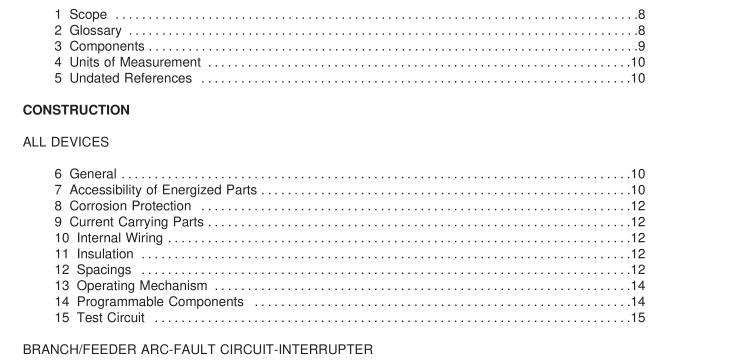UL 1699-2007 pdf download.Arc-Fault Circuit-Interrupters.
1 Scope 1 .1 The requirements of this Standard cover arc-fault circuit-interrupters (AFCIs) of the branch/feeder, outlet circuit, portable, and cord type intended for use in dwelling units. These devices are intended to mitigate the effects of arcing faults that may pose a risk of fire ignition under certain conditions if the arcing persists. 1 .2 AFCIs have a maximum rating of 20 A and are intended for use in 1 20-V ac, 60-HZ circuits. Cord AFCIs are rated up to 30 A. 1 .3 These devices are not intended to detect glowing connections. 1 .4 In these requirements the term device is used generically to apply to all of the devices covered by these requirements and is modified when the requirement does not apply to all types. 1 .5 An AFCI that is also intended to perform other functions, such as overcurrent protection, ground-fault circuit-interruption, surge suppression, any other similar functions, or any combination thereof, shall comply additionally with the requirements of the applicable Standard or Standards that cover devices that provide those functions. 1 .6 This standard contains a supplement covering the requirements for Leakage-Current Detector-Interrupters.
2 Glossary 2.1 For the purposes of this Standard, the following definitions apply. 2.2 ARCING – A luminous discharge of electricity across an insulating medium, usually accompanied by the partial volatilization of the electrodes. 2.3 ARCING FAULT – An unintentional arcing condition in a circuit. 2.4 ARC-FAULT CIRCUIT-INTERRUPTER (AFCI) – A device intended to mitigate the effects of arcing faults by functioning to deenergize the circuit when an arc-fault is detected. 2.5 BRANCH/FEEDER ARC-FAULT CIRCUIT-INTERRUPTER – A device intended to be installed at the origin of a branch circuit or feeder, such as at a panelboard. It is intended to provide protection of the branch circuit wiring, feeder wiring, or both, against unwanted effects of arcing. This device also provides limited protection to branch circuit extension wiring. It may be a circuit-breaker type device or a device in its own enclosure mounted at or near a panelboard. 2.6 CARBONIZED PATH – A conductive carbon path formed through or over the surface of a normally insulating material. 2.7 COMBINATION ARC-FAULT CIRCUIT-INTERRUPTER – An AFCI which complies with the requirements for both branch/feeder and outlet circuit AFCIs. It is intended to protect downstream branch circuit wiring and cord sets and power-supply cords.
2.8 CORD ARC-FAULT CIRCUIT-INTERRUPTER – A plug-in device intended to be connected to a receptacle outlet. It is intended to provide protection to the power-supply cord connected to it against the unwanted effects of arcing. The cord may be integral to the device. The device has no additional outlets. 2.8.1 MICROELECTRONICS – Monolithic, hybrid, or module circuits, where the internal circuit connections are not accessible exclusive of provided external connection pins or pads. The circuits are capable of functioning in the analogue mode, digital mode, or a combination of the two modes. Examples of microelectronics include: ASICs, ROMs, RAMs, PROMs, EPROMs, PALs, and PLDs. See 2.1 1 .1 . 2.8.1 added November 8, 201 3 2.9 OPERATION INHIBITION – Denotes the concealment of an arcing fault by the normal operation of certain circuit components. 2.1 0 OUTLET CIRCUIT ARC-FAULT CIRCUIT-INTERRUPTER – A device intended to be installed at a branch circuit outlet, such as at an outlet box. It is intended to provide protection of cord sets and power-supply cords connected to it (when provided with receptacle outlets) against the unwanted effects of arcing. This device may provide feed-through protection of the cord sets and power-supply cords connected to downstream receptacles. 2.1 1 PORTABLE ARC-FAULT CIRCUIT-INTERRUPTER – A plug-in device intended to be connected to a receptacle outlet and provided with one or more outlets. It is intended to provide protection to connected cord sets and power-supply cords against the unwanted effects of arcing. 2.1 1 .1 PROGRAMMABLE COMPONENT – Any microelectronic hardware that can be programmed in the design center, the factory, or in the field. Here the term ″programmable″ is taken to be ″any manner in which one can alter the software wherein the behavior of the component can be altered.″ The microelectronics defined in 2.8.1 are examples of programmable components. UL 1699-2007 pdf download.
UL 1699-2007 pdf download
